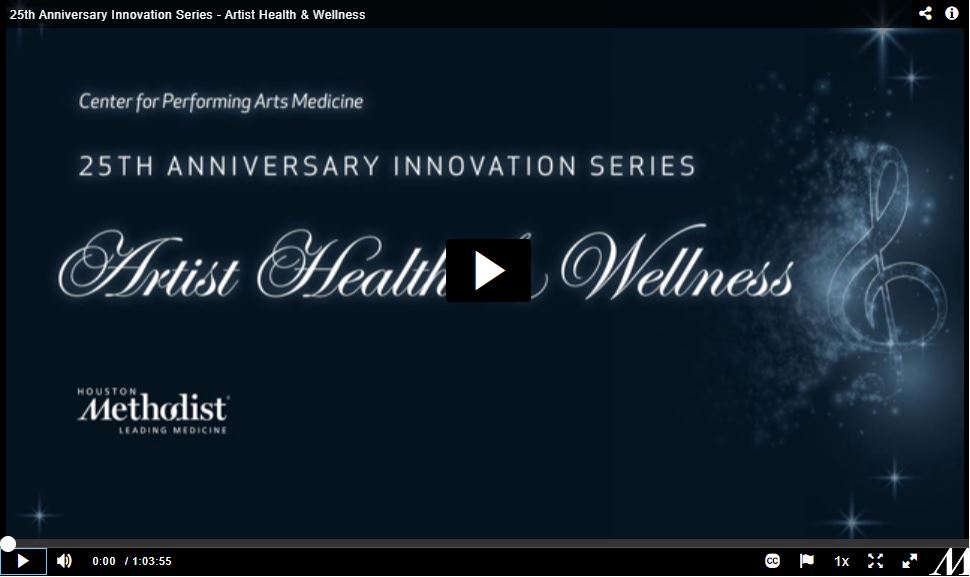Center for Performing Arts Medicine at Houston Methodist: An Integrated Hospital Arts Program
J. Todd Frazier; Shay Thornton Kulha; and Caroline Docwra
https://doi.org/10.52713/MQAC5210
Abstract
The Center for Performing Arts Medicine (CPAM) at Houston Methodist, a system of eight hospitals in greater Houston, Texas, is part of the Texas Medical Center, the largest medical center in the world. CPAM provides specialized healthcare and wellness education to performing artists, meaningful integration of the performing and visual arts into the hospital environment, creative arts therapy utilizing the arts in support of clinical patient goals, research that seeks to harness the broadest potential of the arts in therapy, rehabilitation and human performance, and education and outreach that connects the arts-in-health field across disciplines inspiring creative thinking and discovery. The Center for Performing Arts Medicine is a unique arts-in-health center integrated into the fabric of the Houston Methodist hospital system. CPAM’s programs are developed in collaboration with Houston Methodist’s employees, visitors, and patients.
Keywords: arts in healthcare, arts in health, arts, art therapy, burnout, creative arts therapies, employee retention, healthcare design, music, music therapy, wellness
Background
Founded in 1996 by Dr. C. Richard Stasney, an otolaryngologist who was dubbed the “Opera Doc” for his expertise in caring for voice performers, the Center for Performing Arts Medicine (CPAM) at Houston Methodist grew from an idea to an integrated expertise of Houston Methodist. Dr. Stasney’s original vision for the center focused on caring for performing artists and aligning their healthcare with their artistic and professional needs.
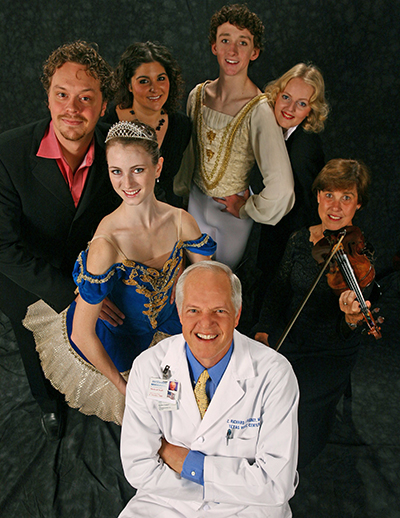
Soon, performers from across the country—and beyond—were seeking him out with ailments of the whole body. He hand-selected physicians from across service lines to care for artists’ various needs, making CPAM the go-to health home for Houston’s performing artists. While CPAM has expanded beyond the care of professional artists, the innovative and can-do attitude of Dr. Stasney remains a core value.
Today, the overarching mission of the center is to effectively translate the collaborative potential of arts and medicine into the healthcare environment. To achieve its mission, CPAM supports the following four pillars:
-
Specialized healthcare and wellness education of performing and visual artists.
-
Effective and meaningful integration of the performing and visual arts into the hospital environment.
-
Therapy that utilizes the arts in clinical patient care.
CLICK IMAGE BELOW TO BE REDIRECTED TO THE FOLLOWING LINK: https://www.houstonmethodist.org/performing-arts/creative-arts-therapy
-
Research that seeks to harness the broadest potential of the arts in therapy, rehabilitation, and human performance.
CLICK IMAGE BELOW TO BE REDIRECTED TO THE FOLLOWING LINK: https://townsend.hmailabs.org/
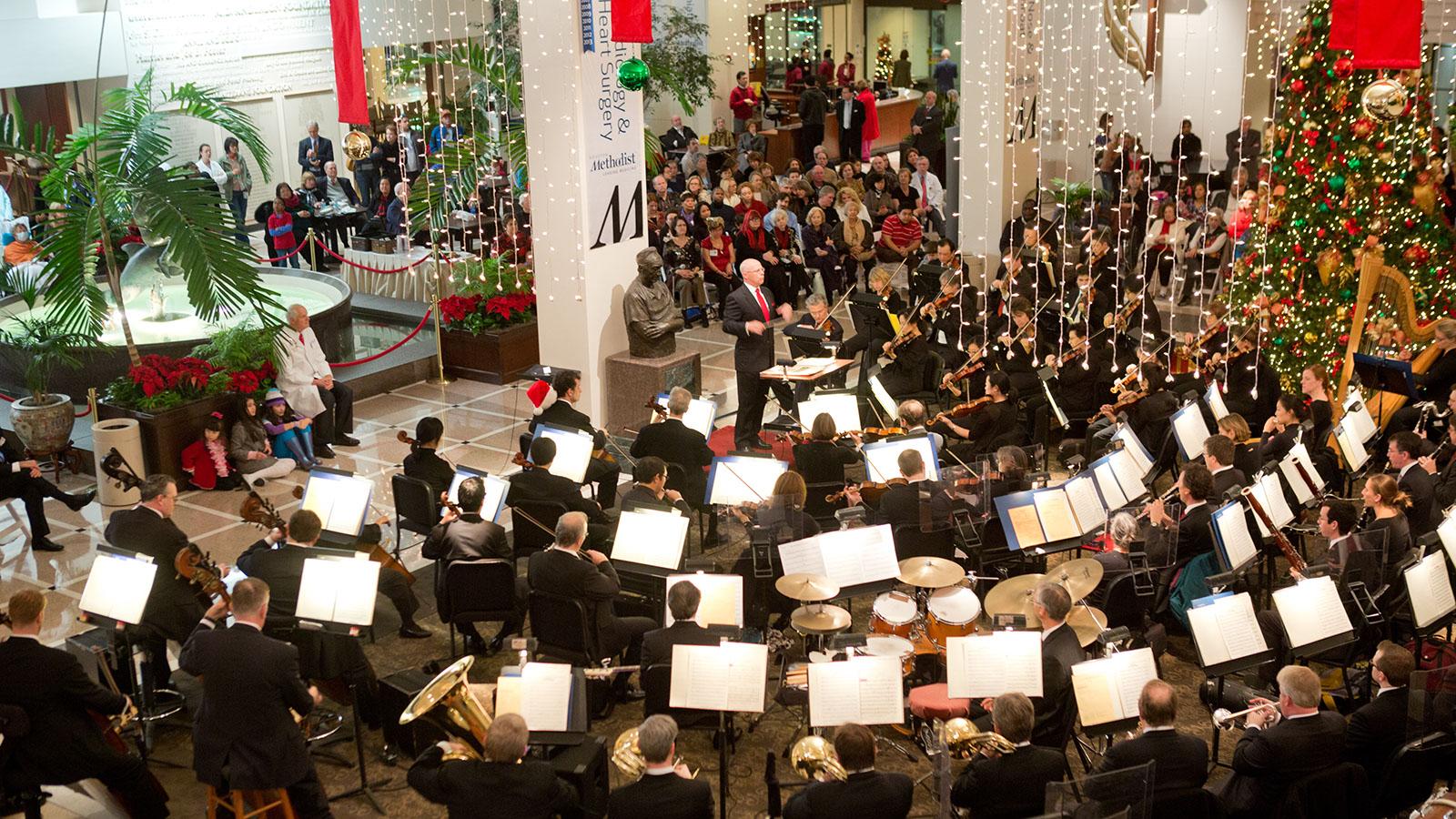
Arts Integration
The meaningful integration of the performing and visual arts into the hospital environment is a key strategy of CPAM’s mission. CPAM views arts integration as high-quality, purposeful programming, presented in patient and community areas throughout the Houston Methodist system. “High quality” refers to the technical expertise of the artists, while “purposeful” refers to the goal of the artwork presented: to relieve anxiety by creating a welcoming environment of solace, offering emotional and spiritual inspiration, and supporting the journey of healing and caregiving for all. This approach was implemented to contribute to Houston Methodist’s culture, reputation in the community, patient satisfaction scores, and values of integrity, compassion, accountability, respect, and excellence (I-CARE).
Crain Garden Performance Series
The Margaret Alkek Williams Performance Series at Houston Methodist Hospital brings live performances to patients and visitors. The series features over 100 performances annually by individuals and members of different local and touring arts groups and takes place in the larger public hospital lobbies of Crain Garden in Dunn Tower and Bush Atrium in Walter Tower. During the pandemic, all in-person performances at Houston Methodist were put on pause, but the desire from artists to share their music with Houston Methodist never stopped. Artists and organizations created virtual content, which CPAM shared on the in-room TV channel across the hospital and on CPAM’s YouTube site that could be accessed systemwide.
Art Trays
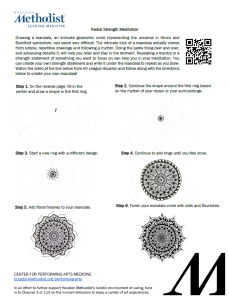
Patient meal trays became an important tool to connect with patients during the height of the pandemic, when room access was limited. Printed interactive activities allowed patients to participate in art activities from the comfort of their room, with all necessary materials delivered on their food tray.
The printed activities provided links for patients to extend their experience by directing them to the CPAM Arts TV channel in their room, digital CPAM resources, or livestreamed performances. Notices about upcoming in-person art experiences were also included for patients to attend if they were approved by their care team to do so.
Art Carts
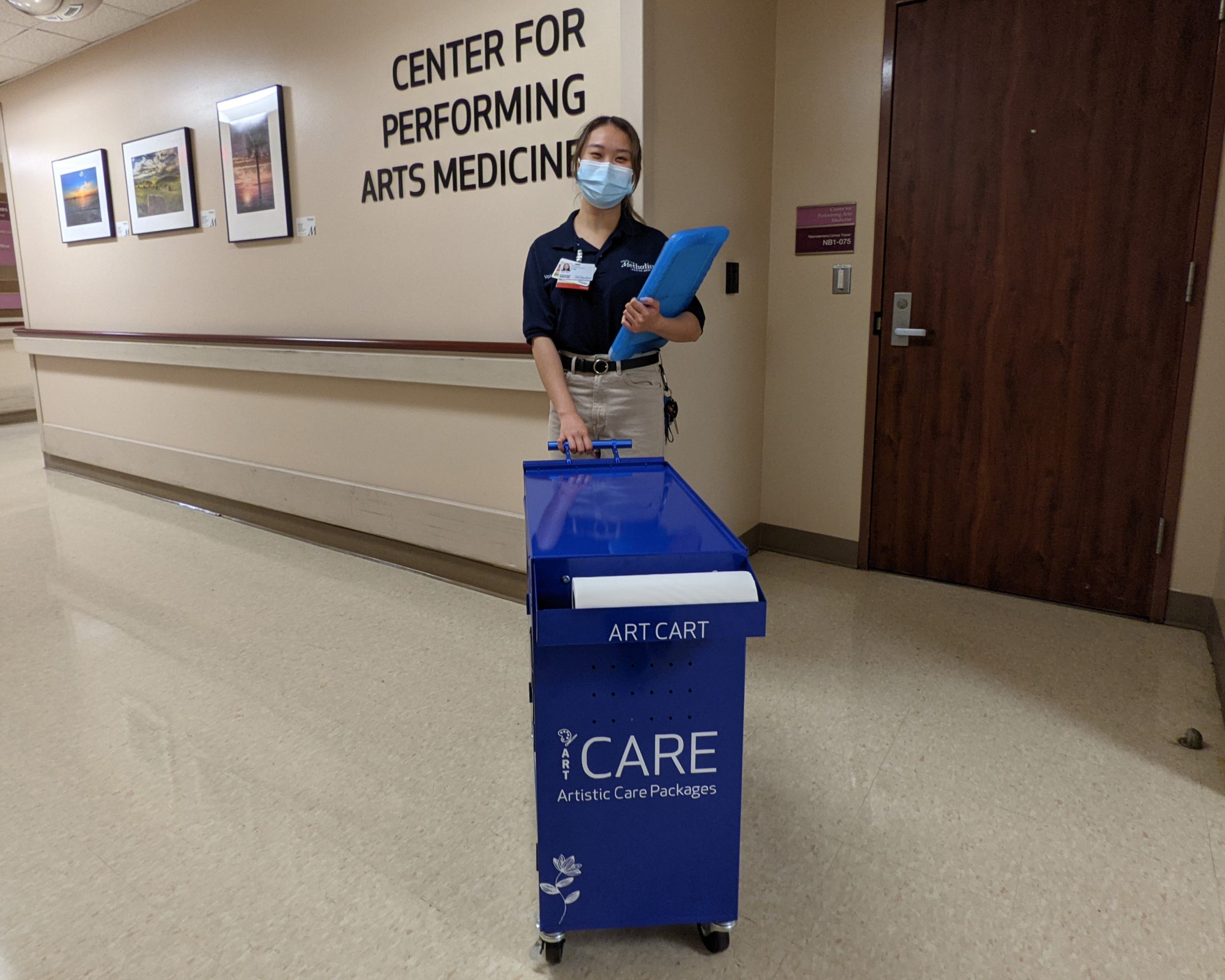
In 2021, CPAM piloted two volunteer-led art carts to bring art experiences to patients’ bedsides. These art carts offer a positive opportunity for patients to engage in the arts during their stay at Houston Methodist.
Each art cart was designed based on the specific needs of Houston Methodist patients, visitors, and units. The ARTcare art cart provides artistic care packages to patients on low-acuity units and in waiting rooms, and the Pick Your Peace art cart allows patients to choose the artwork that is displayed in their rooms in a longer-term, skilled nursing unit. Each cart is intended to impact the patient’s overall experience at Houston Methodist. After each visit with a patient, the volunteer documents their observation of the patient’s mood, if there was a change in their mood, and any pertinent comments from the patient or staff.
Wellness Musicians
Wellness Musicians is a program providing live music from volunteer community musicians at the patient’s bedside. A wellness musician provides music listening opportunities at the bedside to promote rest, relaxation, and respite. Wellness musicians have oversight from board-certified music therapists to safely facilitate encounters between musicians and hospital patients who could benefit from a live music listening experience. Patients are identified for wellness musician visits if they show a need for companionship, relaxation, or redirection. A wellness musician has demonstrated competent performance skills and an ability to maintain professional boundaries during patient interactions.
Healing Arts Photography Exhibition Series
Since 2008, the Healing Arts Exhibition of photography has been a unique benefit for Houston Methodist employees, physicians, and volunteers. This program provides a themed creative outlet for staff expression and highlights the talent of our Houston Methodist employees systemwide. Houston Methodist employees, volunteers, and physicians contribute their personal photographic artwork, and a committee that represents employees and artists curate the annual Healing Arts Exhibition. The competition has become so popular that CPAM now offers free photography classes to anyone on staff who would like to improve their photography skills.
A new exhibition is installed each year in the Healing Arts Gallery at the Texas Medical Center. The employee imagery from the Healing Arts collection is also available for units or departments to redesign their spaces. Departments can also engage their staff and give them agency in the design process by allowing them to vote on the images that would be installed on the unit. The imagery in the Healing Arts collection ranges from wide-open, lush landscapes to beautiful, unique florals and can bring the feeling of nature, peace, reflection, and calm to the unit.
West Pavilion
The photographs from the Healing Arts collection can be seen across the hospital in many different spaces. When a nursing leader came to CPAM with the desire to improve the physical space of her unit, CPAM jumped at the opportunity to bring together a collaborative committee of local arts experts, rehabilitation clinicians, and hospital management to assess the opportunity.
There were several design challenges that needed to be tackled with this project, so the group set out to address four main goals of the space: to enhance the aesthetic appeal of the space for patients, visitors, and staff; to create a healing environment that reduces stressors of the hospital environment; to utilize juried employee artwork to promote a healing environment; and to accommodate clinical goals of the patient population by utilizing art pieces to facilitate therapeutic activities.
Designer Alan Krathaus of Core Design created the final design and installation. From the moment the paint was changed, the atmosphere of the space shifted. What staff and patients once regarded as dull and uninspiring became peaceful, calming, and awe-inspiring. Patients stop and admire the work of their doctors and nurses, and patient liaisons take pictures of families pointing up to the inspirational words as a memento of their experience at Houston Methodist. Overall, this installation has made a tremendous impact on the environment and how the clinical team utilizes the space. The impact even reached those who worked on this project. Krathaus himself remarked, “Once again, I was reminded of the empathy and compassion that blooms from the people who help those in need and their willingness to express their feelings in a positive way. I’m so glad we were a part of it.”
Employee Arts Enrichment

Houston Methodist understands the heightened stress of working in healthcare, whether one is a direct caregiver or in a support role, and knows that engaging creatively through the arts encourages self-discovery and provides opportunities to reflect or process a challenging experience while learning new skills.
Employee Arts Enrichment programming describes a range of programs from opt-in creative arts enrichment experiences (like classes or museum visits) to staff support initiatives curated in partnership with team leadership in response to a specific area of need or event. We believe the continuum of programming serves different employee needs and expectations on how they’d like to engage with the arts. The continuum starts with arts enrichment programs like opportunities to visit a museum, attend an arts class, or participate in a community choir. These programs may be utilized by employees who are looking to express themselves creatively, meet new colleagues, or deepen their artistic skills. The programs continue to build in specificity toward an associated goal across the continuum. The most in-depth, therapeutic programs are Specific Event Response Staff Support opportunities facilitated by CPAM creative arts therapists in tandem with team leaders. The response-based programs utilize the arts to serve a unit in need of trauma processing or team building after a challenging event, such as the loss of a long-term patient or fellow employee or when facing a stressful event such as an epidemic, natural disaster, or community tragedy. This programming is always free and specifically curated for healthcare personnel.
Employee Classes
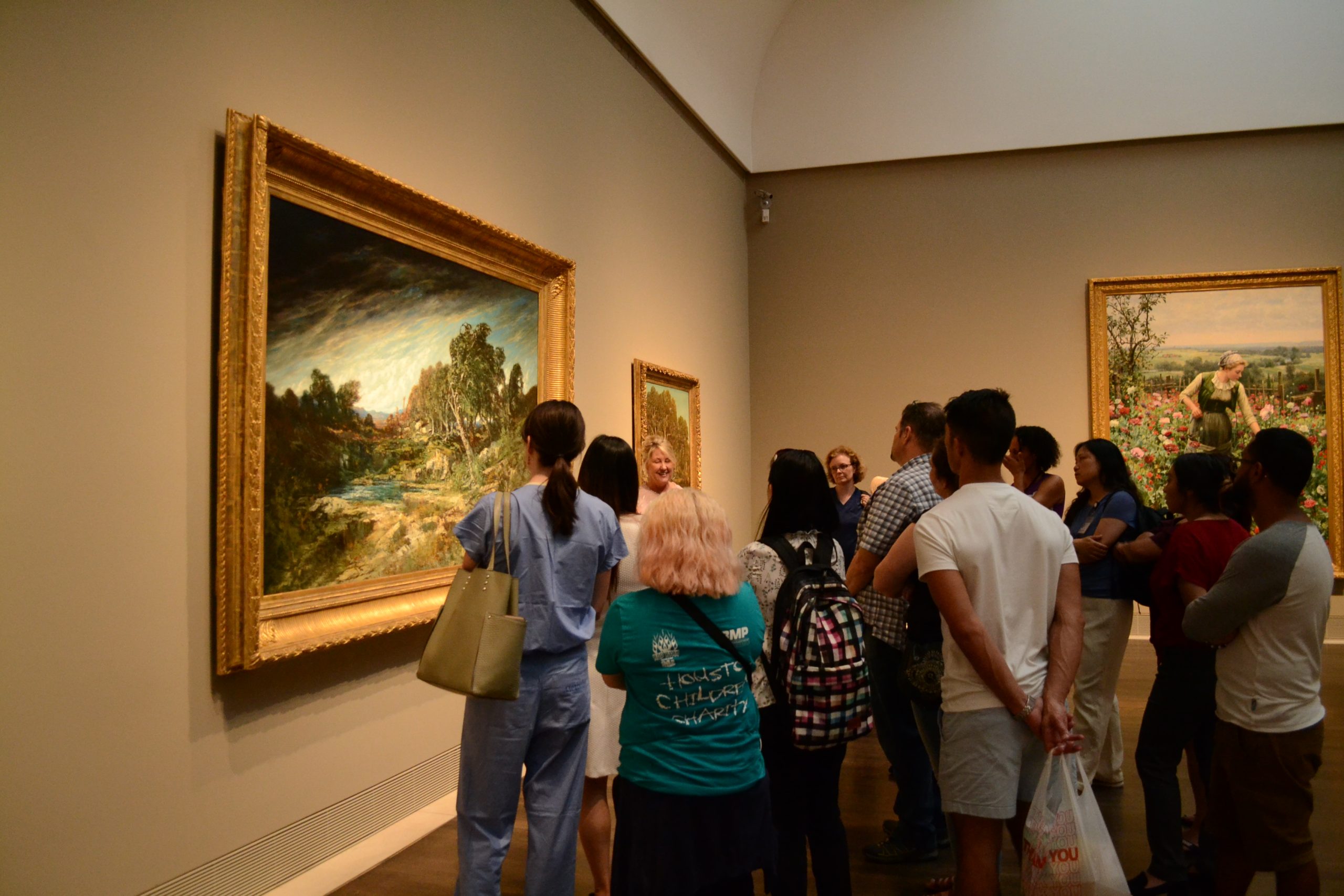
With activities offered every week of the year through diverse artistic genres such as choir, photography, creative writing, origami, and museum visits, employees are presented with opportunities to engage in the arts with colleagues while working on resiliency-building skills that tend to lower employee burnout rates. Realizing that there is no one-size-fits-all in terms of artistic genre, scheduling option, or interest level, CPAM has developed a variety of resiliency-building art enrichment experiences to meet the diverse needs of Houston Methodist employees. From eight-week intensive creative writing classes led by Inprint, one of Houston’s oldest literary arts organizations, to curated digital content, CPAM provides employee arts enrichment opportunities that meet varying levels of need in terms of engagement and accessibility.
Splatter Paint Tent
The Cardiovascular ICU (CVICU) staff at Houston Methodist worked tirelessly throughout the COVID-19 pandemic. Staff remarked that it felt like a wild rollercoaster ride, with new situations and protocols evolving constantly. Many needed an outlet for the release of tension, negative emotions, or even anger at the situation in which they found themselves. In response to this need for catharsis, CPAM, CVICU management, and facilities management created the Splatter Paint Tent, a contained area on the unit specifically designed for releasing tension.
Each staff member had an opportunity to don protective clothing, enter the zippered tent, choose a preferred music playlist, select their lighting, and “let it all out” by splattering paint anywhere on the provided canvas. The Splatter Paint Tent provided a safe place for staff to shut the world out for a few moments and splatter some paint as gently or as forcefully as they wished. The Splatter Paint Tent culminated in a paper mosaic, comprised of 26 individual 6-foot-wide canvases painted by the CVICU staff, which was a visual representation of both the people and the physical expressions of catharsis from the CVICU.
The need for this type of release is ongoing, so the Splatter Paint Tent continues to travel to different units across the Houston Methodist system.
Choir
The Houston Methodist Singers, an all-employee choir, offers employees at four of the Houston Methodist hospitals the opportunity to come together for fellowship and music making. Now with over 80 members, the choir meets on a regular basis, performing at major sporting events (like Houston Astros’ games) and internal hospital events (like layperson minister celebrations and Martin Luther King Jr. Day).
Interestingly, almost 90% of the choir’s members have never been part of a formal music-making group before. The choir brings together people from different departments and hospitals across the system who would not otherwise have an opportunity to interact and make connections.
Artful Moments
Every Friday at noon, CPAM offers 15-minute virtual presentations called Artful Moments on Microsoft Teams. These short meetings give any Houston Methodist employee a moment to focus on art, relax, and think about something outside their day-to-day work. CPAM staff hosts these meetings and offer activities for employees to color, interact, or listen to music, prompting them to include art in their weekly routine. Activities range from collaborative drawing on Teams’ built-in whiteboard application to listening to a thrilling tale of an artist’s life to an interactive chat with our in-house pianists where participants can request their favorite songs.
Family Art Experiences
CPAM also recognizes that employees’ family units can be affected by the unique stressors of working in healthcare. In support of providing holistic wellbeing resources, CPAM creates annual opportunities for families to engage with the arts and reflect on challenges. For example, during COVID-19, CPAM worked with author and illustrator LeUyen Pham for a live reading of Outside, Inside.
This book explains that, for the safety of communities during the pandemic, most people were advised to stay home as much as possible, while front-line workers were encouraged to continue working outside. CPAM led a discussion about how it felt if a parent or guardian had to go to work but a child wasn’t allowed to go to school. The event, hosted by physician leadership, also included a family-oriented art therapy activity that served as a bridge between employees’ home lives and their work, perhaps deepening their connection to the organization.
Collaborative Art Projects
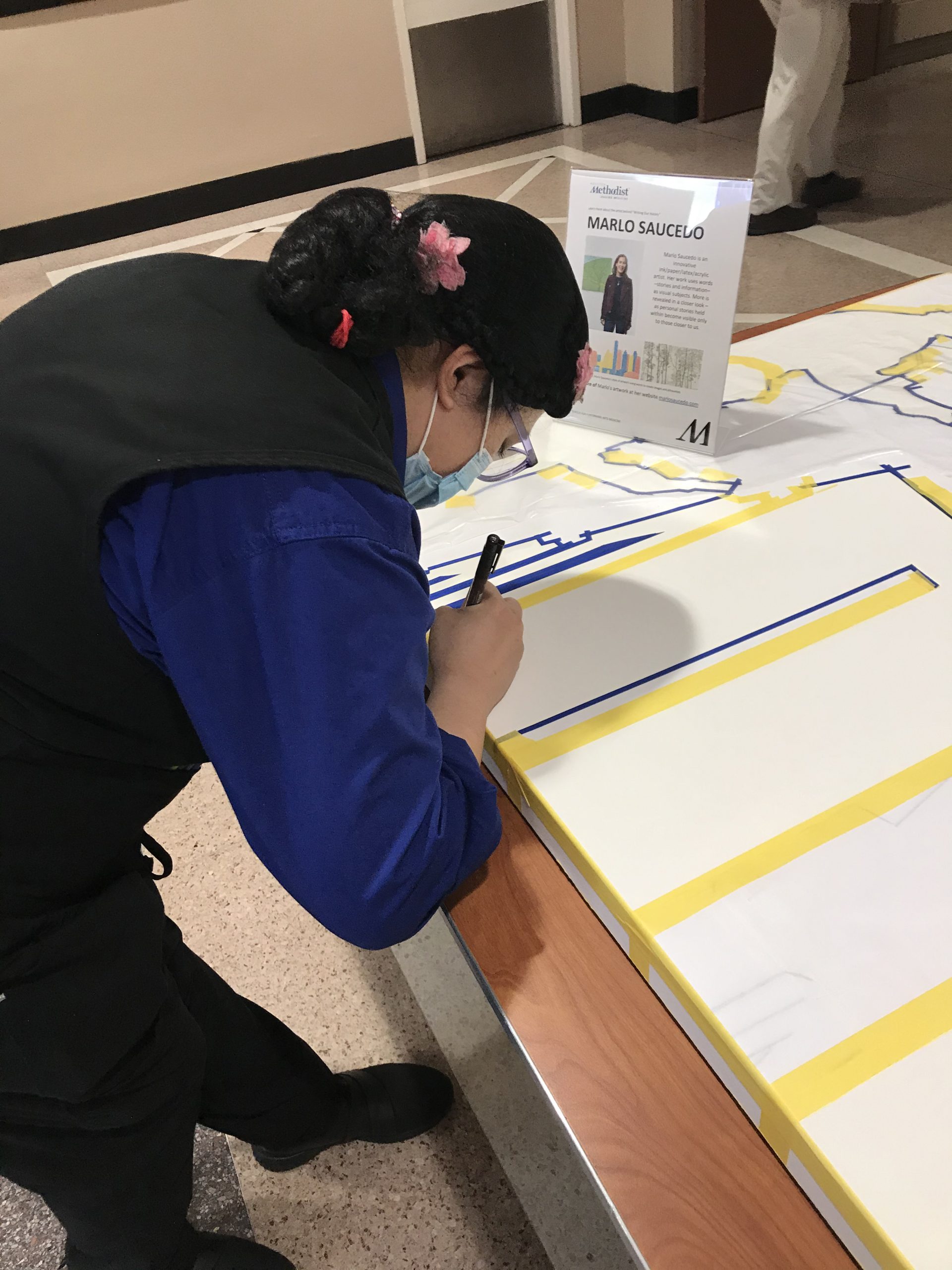
Employees are regularly invited to participate in the arts and express their contribution to the healing environment at Houston Methodist. Collaborative art projects are systemwide efforts allowing each hospital to create their own unique works of art using the same processes, resulting in replica works of art that tell the story of each hospital. “Writing Our History” is an interactive art piece created by Houston Methodist employees marking the one-year anniversary of caring for our community throughout COVID-19. The piece was designed by local artist Marlo Saucedo and is composed of individually signed names of employees at Houston Methodist. At first glance, a viewer sees the figures of healthcare workers, but upon closer inspection each figure is composed of the names of those who contributed to the hospital that year. Additionally, the butterfly, “Metamorphosis,” shows how Houston Methodist employees grew in 2020. Responses were encapsulated in a stained-glass butterfly handcrafted by local artist Melissa Aytenfisu in partnership with the Museum of Fine Arts, Houston. As one views the butterfly, the light resiliently shines through it, reflecting the enduring spirit of the Houston Methodist community. Each hospital has its own butterfly on display to depict employees’ different responses while also emphasizing their unified intentions.
Partnership with Diversity, Equity, and Inclusion
In 2020, Houston Methodist established the Office of Diversity, Equity, and Inclusion, which eventually led to the launching of employee resource groups (ERGs.) These groups were created by employees to be a forum to support each other, discuss common interests, and raise awareness of issues they may be facing. ERGs include Arab Heritage, Asian Heritage, Black Ties for Culture, Hispanic Latinx Alliance, LGBTQ+ Allies, Moms of Methodist, Veterans Alliance, and Women’s Empowerment Alliance. After the creation of these groups, CPAM began supporting them through a wide variety of arts experiences and performances, all in response to a group’s needs and requests.
For Pride month, CPAM organized a collaborative art activity to create an art piece using rainbow-color butterflies. On the butterflies, members wrote a response to one of these two prompts: “what Pride means to you” or “positive affirmations for Pride Month.” Those who work from home or could not attend the event could still participate by completing an online form with their response to the prompts. This more accessible option grew from the need to be virtual at the beginning of the pandemic, but the online option remains in place so all have the chance to participate in CPAM’s programming no matter their circumstances, disabilities, or locations.
Creative Arts Therapy
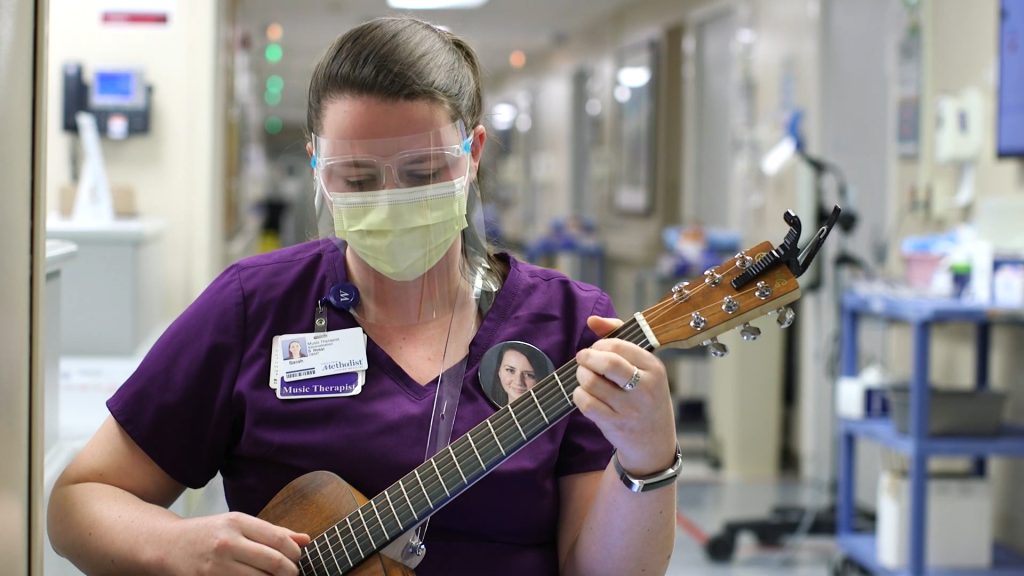
Houston Methodist has one of the largest teams of creative arts therapists (CAT) in the country.
Creative arts therapists are human service professionals who use evidenced-based art interventions and creative processes to ameliorate disability and illness and to optimize health and wellness. At Houston Methodist, our team includes music therapists and art therapists.
These caregivers are embedded in units throughout the system, addressing everything from the beginning of life in the neonatal intensive care unit to life’s end with our palliative care team. Using music or art as part of the therapeutic relationship, the CAT team works with patients to achieve clinical goals.
Started in 2014 with a pilot on inpatient rehabilitation, that part-time, six-month pilot of music therapy has grown into a team of 20 creative arts therapists spread across multiple Houston Methodist locations. These practitioners respond to referrals sent in from physicians, nurses, and staff. The creative arts therapist has become a critical part of the care team, and their expertise is sought to address specific health issues. For example, music therapists work with patients individually through what can be an incredibly stressful process of ventilation weaning. Mechanical ventilation occurs when a patient, often with a significant respiratory illness, uses a machine to power their breathing. Being on a ventilator is an invasive and expensive medical intervention, and when a patient is deemed well enough for “spontaneous breathing” (breathing powered by the patient instead of the machine), steps are taken to wean the patient from their dependence on supported breathing. For the patient, this can be a terrifying process. Individualized music therapy interventions are used during a spontaneous breathing trial (SBT) to decrease the patient’s perceived level of anxiety and improve physiologic metrics related to the SBT, specifically blood pressure, oxygen saturation, respiratory rate, and heart rate. Through a therapeutic relationship, the music therapist uses music in coordination with the patient and throughout the SBT process, modifying the music in real time in response to the trial. At Houston Methodist, we have seen a much higher degree of success in spontaneous breathing trials when a music therapist is part of the care team, compared with times when they are not.
The creative arts therapy team also provides psychosocial support throughout a patient’s journey. During COVID-19, music therapists created bonding opportunities between mothers and babies who were separated due to their condition. For one expectant mother, her delivery was not how she had envisioned it.
She arrived at Houston Methodist exhibiting acute respiratory distress symptoms from COVID-19 and was medically sedated. She gave birth while sedated via an emergency cesarean. The baby was sent to the neonatal ICU for preterm delivery. Weeks later, the mother was well enough to be removed from medical sedation and was informed of her child’s birth. This medically and emotionally challenging situation was supported by music therapy through heartbeat recordings. The recordings, made from the mother and baby’s heartbeats overlaid with preferred music, provide a unique opportunity to address clinical and emotional well-being. In support of clinical goals, the mother’s heartbeat overlaid by a favorite lullaby induced homeostasis in the infant and allowed the baby to focus on eating and increasing calorie intake. In support of emotional well-being, the heartbeat of the baby overlaid by a song meaningful to the family allowed the mother to develop and strengthen her emotional connection to her child and husband even while separated physically.
Research
CPAM’s research team engages in aspires to create an evidence-based framework for how the arts can be harnessed in therapy, rehabilitation, and human performance. The connection to Houston Methodist’s research institute gives CPAM access to imaging technology that allows for a physiological look into how the arts impact our brains, bodies, and healing. Along with the research projects that CPAM takes on at Houston Methodist, CPAM collaborates with other institutions locally and nationally.
One of CPAM’s current research projects focuses on how music can improve health outcomes for stroke patients. Strokes occur when there is a blockage of blood flow to an area of the brain. The brain loses access to oxygen and nutrients because of the blockage, which can result in lasting damage. CPAM researchers are trialing directed music listening playlists, developed in partnership with researchers, doctors, and music medicine practitioners, to non-invasively improve blood flow to damaged parts of a stroke patient’s brain, aiding in recovery.
A second CPAM research project is Project Chroma. In partnership with Musiqa, a Houston-based contemporary music ensemble, Rice University launched Project Chroma, an interdisciplinary initiative at Rice University and a National Endowment for the Arts Research Laboratory site. Project Chroma is working with Houston Methodist to utilize fMRI technology to measure the effects of music-making and music engagement on cognitive and social-emotional well-being of older adults with mild cognitive impairments. Participants will undergo a six-week course combining musical exposure, creation, and performance. The curriculum cognitively challenges participants through music listening, theory, performance, and creation activities. Preliminary results from the program show improvements in measures of cognitive function—specifically in working memory, which is essential for attention. This research suggests that group music creativity classes could benefit older adults not only by engaging them in something meaningful, but also by improving their cognitive function.
CPAM research looks to improve provider wellbeing as well. CPAM is partnering with University of Houston Music Professor Todd Van Kekerix to study the effects of participatory art experiences on nurses’ mood states, including burnout. The study will measure the effects of two types of art classes: a keyboard group music-making workshop and a visual art-making collaborative workshop, against validated mood and burnout scales for nurses. This will allow for insight into the impact of CPAM’s programming for employees and provide quantitative data to share with our leadership and across the healthcare field.
Artist Health
Core to its mission, CPAM remains steadfastly committed to the health of artists. Providing a health home to Houston artists, CPAM knows that the health challenges of artists are different and more specialized than those of an average patient.
Just as Houston Methodist treats professional athletes through a sports medicine lens, CPAM has a roster of physicians who are committed to caring for professional artists. This commitment includes a dedicated artist health-facilitated care liaison. The liaison connects artists with physicians who accept their insurance and will see them in an expedited fashion.
Beyond the facilitation, artists are also offered membership in the free artist card program. This program tags all artists that come into Houston Methodist so anyone who opens their electronic medical record knows that they are an artist and may have specific health priorities. For example, if an opera singer were to walk into an emergency department and were known to be an artist from the tag in their record, an emergency department physician might avoid using certain antihistamines that could irritate their vocal cords. This small adjustment in medication could make a significant impact on the performer’s work. CPAM’s roster of physicians considers the artistic needs of these patients in congruence with their physical ailments.
CPAM’s dedication to artist health also includes being the official healthcare provider for the Houston Symphony, the Houston Ballet, the Houston Grand Opera, and the Ensemble Theatre. These sponsorship relationships all include access to the facilitated care program, health education opportunities, and the ability to consult with Houston Methodist physicians as needed. For example, at the Center for Dance in the Houston Ballet, Houston Methodist has an on-site presence for their dance company. This includes physical trainers, massage therapists, and access to specialty orthopedic physicians. This relationship leads to exceptional care that helps dancers maintain their peak performance.
Outreach and Education
Another core value of CPAM is to elevate the field of arts in health. This includes spreading awareness of the field in the overall community and broadening career opportunities. CPAM sponsors and partners with international, national, and local organizations to share examples of high-quality arts-in-health programming and collaborates to support the professionalization of the field. CPAM is unique as an integrated hospital department, and our programs serve as models of how to bring arts into a hospital environment in a sustainable way.
Future Plans for CPAM
In 2015, CPAM created a strategic plan to expand services to the entire system of eight hospitals. Since then, CPAM has grown exponentially and continues to navigate the needs of the hospital system proactively. CPAM is careful to consider how the arts can provide solutions to the changing needs and challenges of healthcare regionally and nationally, and how the arts can continue to support the holistic environment of care at Houston Methodist.
CPAM has been recognized by Texas Cultural Trust as a 2021 Medal of the Arts recipient, by Americans for the Arts as a 2017 Arts + Business Partnership awardee, and from the National Organization for Arts in Health as a Hamilton International Arts in Health awardee. “Leading Medicine” is the motto of Houston Methodist, and CPAM is proud to have become an integral part of the fabric of offerings that have helped the hospital realize its potential, achieving, as of 2023, a #1 ranking in Texas for 13 years from the U.S. News and World Report.





